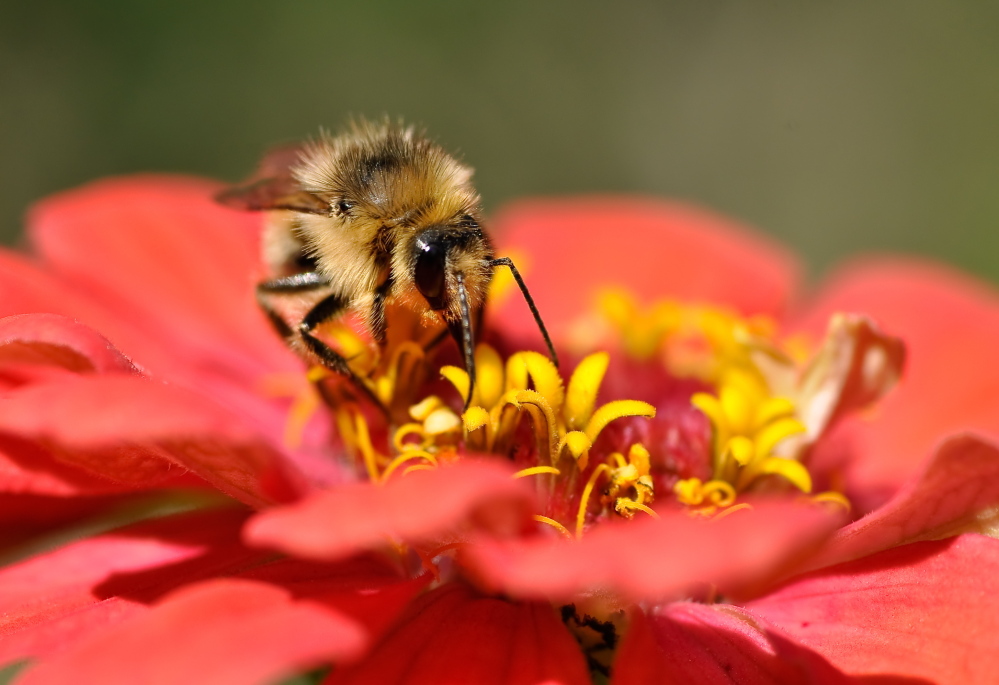Honeybees are in trouble – in Maine, all over the place. Just about everyone agrees.
The disagreement comes about what is causing the problems and, more than that, what should be done.
A daylong conference earlier this fall sponsored by the University of Maine Cooperative Extension Service and the Maine Department of Agriculture, Conservation and Forestry looked into those questions.
The conference, held in South Portland, was prompted by a bill introduced in the Maine Legislature two years ago to place a moratorium on the use of neonicotinoid pesticides, which work by drawing insect-killing substances into the tissue of plants. Although that initial legislation was withdrawn (the sponsor consulted with the Maine State Beekeepers Association, which found flaws), a rewritten version that would allow use of the pesticides by commercial farmers is expected to be introduced in the coming session.
Why all the attention to honeybees? Because most of the food we eat requires pollination, and honeybees carry out most of that work. The bees are a $25 billion industry in the United States, John Skinner of the University of Tennessee said in remarks at the start of the conference.
As anybody who hasn’t lived in a cave for the last five-plus years knows, the biggest problem honeybees face is colony collapse disorder, in which hives mysteriously die or disappear. The disorder got its name in 2006, but there were instances of it before then, and European honeybees had problems for decades earlier.
Honeybees face a variety of difficulties, all of which may be contributing to colony collapse disorder. They are attacked by mites, both tracheal mites and varroa mites. They get infections, including foulbrood and nosema. They are overworked, their hives hauled from place to place to pollinate crops, which can cause stress – like people who work 80-hour weeks. Bees who eat pollen solely from the crops that humans want pollinated, say blueberries, can suffer from malnutrition; healthy bees need food from many different plants, not a monoculture. And interbreeding may be weakening the bee gene pool.
On top of all that, many pesticides kill bees.
“We are dealing with a complex issue,” Maine state apiarist Tony Jadczak summed up for the 250 attendees after some seven hours of presentations from professors, scientists and government officials. “Banning one class of insecticides will not fix this problem.”
That said, neonicotinoids have come in for a lot of criticism. The European Union recently enacted a moratorium on their use. The EU was supposed to develop a monitoring program on how the moratorium is affecting the honeybees, said David Epstein of the U.S. Department of Agriculture Office of Pest Management Policy. “They are not doing that, and to me that is really frustrating.”
Nancy Ostiguy of the Penn State Department of Entomology presented a lot of detailed technical information about pesticides, but here’s how she began: “The big conclusion of what I have to say is that we don’t have a clue about what is going on.”
For example, people have assumed that herbicides – which kill plants – are safe for animals, she said, but that is not necessarily true. One complication is that most research is done when a pesticide kills insects immediately because researchers can more easily connect cause and effect; less research exists on chronic effects that may build up over years, gradually harming insects, she said.
Pesticide mixing is also insufficiently researched. For example, when fungicides mix with neonics, the result may be much more toxic than either one used separately, Ostiguy said.
Several speakers expressed concerns about a new pesticide being considered for release, flupyradifurone. It is similar to neonicotinods in that it is a systemic, but it is in a different class (because it kills insects in a different way). Field studies show that flupyradifuron is less toxic to bees; Ostiguy has her doubts.
Many at the conference also expressed concern that a lot of these pesticides are used on ornamental gardens – designed simply to please the eye – rather than on farms, which produce the food we need to live. No matter the activity, people always must consider benefits versus risks, Ostiguy noted. “It matters a lot who is asking the question,” she said. “The beekeeper, the grower, the farmer and the homeowner all have different perceptions and different benefits and risks.”
Despite the criticism leveled at neonicotinoids, several speakers said that they have been shown to be less harmful to humans and to pollinators than the pesticides they replaced: organophosphates, carbamates and pyrethroids. They also agreed that when pesticides are applied by professionals – whether for food production or ornamental gardens – they are usually less harmful than when applied by homeowners, who tend to neither read nor follow label instructions.
And finally, they agreed that the debate will continue for a long time to come.
Tom Atwell is a freelance writer gardening in Cape Elizabeth and can be contacted at 767-2297 or at tomatwell@me.com.
Send questions/comments to the editors.



Success. Please wait for the page to reload. If the page does not reload within 5 seconds, please refresh the page.
Enter your email and password to access comments.
Hi, to comment on stories you must . This profile is in addition to your subscription and website login.
Already have a commenting profile? .
Invalid username/password.
Please check your email to confirm and complete your registration.
Only subscribers are eligible to post comments. Please subscribe or login first for digital access. Here’s why.
Use the form below to reset your password. When you've submitted your account email, we will send an email with a reset code.